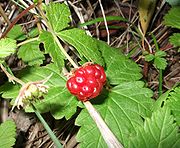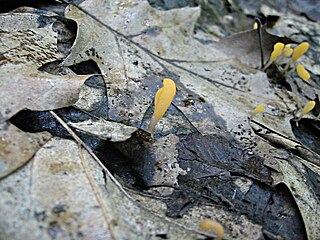
Mitrula paludosa, the swamp beacon (US) or bog beacon, (UK) is a species of fungus. It is inedible.

Hypholoma lateritium, sometimes called brick cap, chestnut mushroom, cinnamon cap, brick top, red woodlover, or kuritake is rarer and less well-known than its relatives, the inedible, and poisonous sulfur tuft and the edible Hypholoma capnoides. Its fruiting bodies are generally larger than either of these. Hypholoma sublateritium is a synonym.
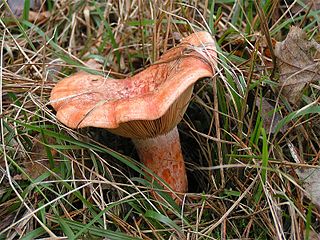
Lactarius deliciosus, commonly known as the saffron milk cap and red pine mushroom, is one of the best known members of the large milk-cap genus Lactarius in the order Russulales. It is found in Europe and has been accidentally introduced to other countries under conifers and can be found growing in pine plantations. A fresco in the Roman town of Herculaneum appears to depict Lactarius deliciosus and is one of the earliest pieces of art to illustrate a fungus.

Amanita citrina, commonly known as the false death cap or citron amanita, is a basidiomycotic mushroom, one of many in the genus Amanita. It grows in silicate soil in the summer and autumn months. It bears a pale yellow or sometimes white cap, with white stem, ring and volva. Though not deadly, it is inedible and often confused for the lethal death cap.
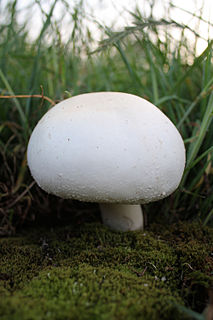
Agaricus arvensis, commonly known as the horse mushroom, is a mushroom of the genus Agaricus.

Agaricus campestris is a widely eaten gilled mushroom closely related to the cultivated button mushroom Agaricus bisporus. It is commonly known as the field mushroom or, in North America, meadow mushroom.

Hygrocybe miniata, commonly known as the vermilion waxcap, is a small, bright red or red-orange mushroom of the waxcap genus Hygrocybe. It is a cosmopolitan species, that is found worldwide. In Europe, it is found in fields, on sandy heaths, or grassy commons in the autumn. It is found in rainforest and eucalypt forest as well as heathland in Australia.

Lactarius rufus is a common, medium-sized member of the mushroom genus Lactarius, whose many members are commonly known as milkcaps. Known by the common name of the rufous milkcap, or the red hot milk cap in North America. It is dark brick red in color, and grows with pine or birch trees.

Baeospora myosura is a species of fungus that produces mushrooms with long, coarse hairs. It grows on plant material and manure. It is white to cream and the spore color is white, cream, or yellowish. It is commonly found in North America and Europe. The common name of the mushroom is conifercone cap. It was described in 1938 by mycologist Rolf Singer. It is regarded as nonpoisonous.

The inedible wild mushroom Russula fragilis, which goes by the common name of the fragile brittlegill, is a member of the genus Russula, whose members are commonly known as brittlegills. It is a small, fragile, long stemmed, and variably coloured brittlegill, found in mixed forests, and woods in Europe, Asia, and North America.

Grifola frondosa is a polypore mushroom that grows at the base of trees, particularly old growth oaks or maples. It is typically found in late summer to early autumn. It is native to China, Europe, and North America.

Amanita vaginata, commonly known as the grisette or the grisette amanita, is an edible mushroom in the fungus family Amanitaceae. Unlike many other Amanita mushrooms, A. vaginata lacks a ring on the stem. The cap is gray or brownish, 5 to 10 centimetres in diameter, and has furrows around the edge that duplicate the gill pattern underneath. It has a widespread distribution in North America, and is thought to be part of a species complex that includes other similar-looking Amanitas.
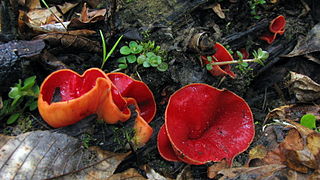
Sarcoscypha austriaca is a saprobic fungus in the family Sarcoscyphaceae of the order Pezizales of Ascomycota. It is commonly known as the scarlet elfcup, pézize écarlate and scharlachroter kelchbecherling. The species name means "from Austria".

Paxillus vernalis is a basidiomycete fungus found in montane forests in northern North America. It closely resembles the poisonous Paxillus involutus, and is considered likely to also be poisonous. The fungus was described as new to science by Scottish mycologist Roy Watling in 1969.
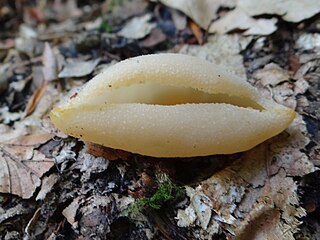
Tarzetta catinus is a species of apothecial fungus belonging to the family Pyronemataceae. This is a largely European species with a few records from Mexico and the United States. It appears from spring to autumn as cream-coloured cups up to 5 cm across, usually in small groups among broad-leaved trees, especially beech. The rather similar Tarzetta cupularis is usually a smaller, deeper, flask-shaped cup, but the two species can only be reliably distinguished microscopically: by the shape of the spores and the paraphyses.

Morchella deliciosa is a species of edible fungus in the family Morchellaceae. It was first described scientifically by Elias Magnus Fries in 1822. It is a European species, although the name has erroneously been applied to morphologically similar North American morels.

Amanita excelsa, also known as the European false blushing amanita, is a species of agaric fungus in the family Amanitaceae. It is found in Asia, Europe, and North America, where it grows in deciduous forests.

Clavariadelphus pistillaris is a rare species of mushroom of the family Gomphaceae native to Europe and North America. It grows during summer and autumn almost exclusively in beech forest on calcareous soil on litter and woodchips.

Inosperma calamistratum, until 2019 known as Inocybe calamistrata, is an inedible species of Inocybaceae fungus found in Europe and North America. Orson K. Miller Jr. and Hope Miller list it as poisonous.
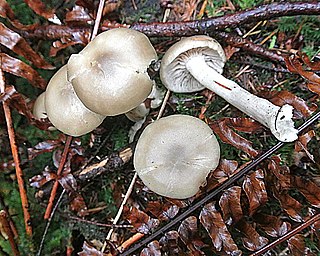
Entoloma sericellum is a species of mushroom-forming fungus belonging to the family Entolomataceae. It appears in conifer and hardwood forests.




